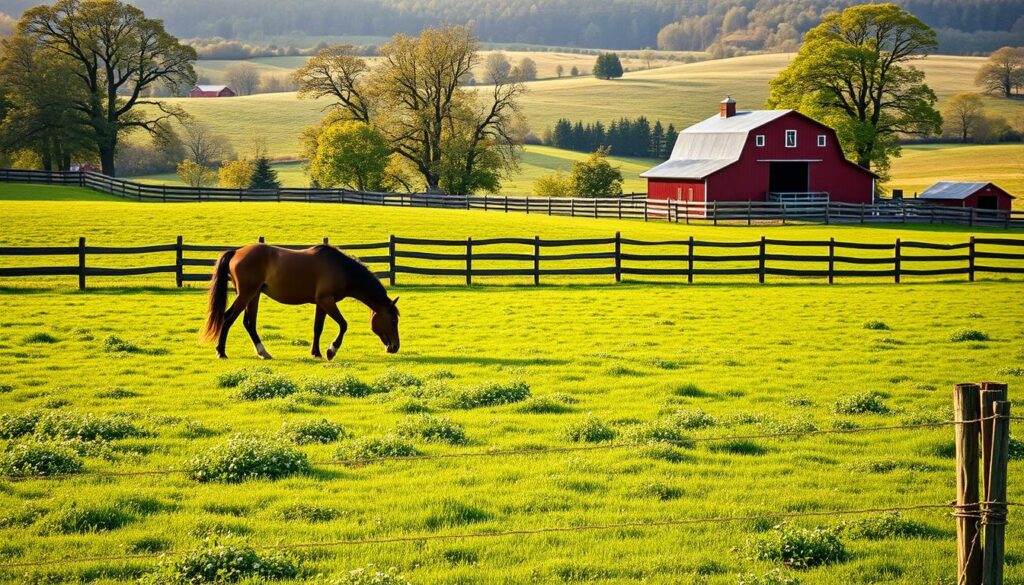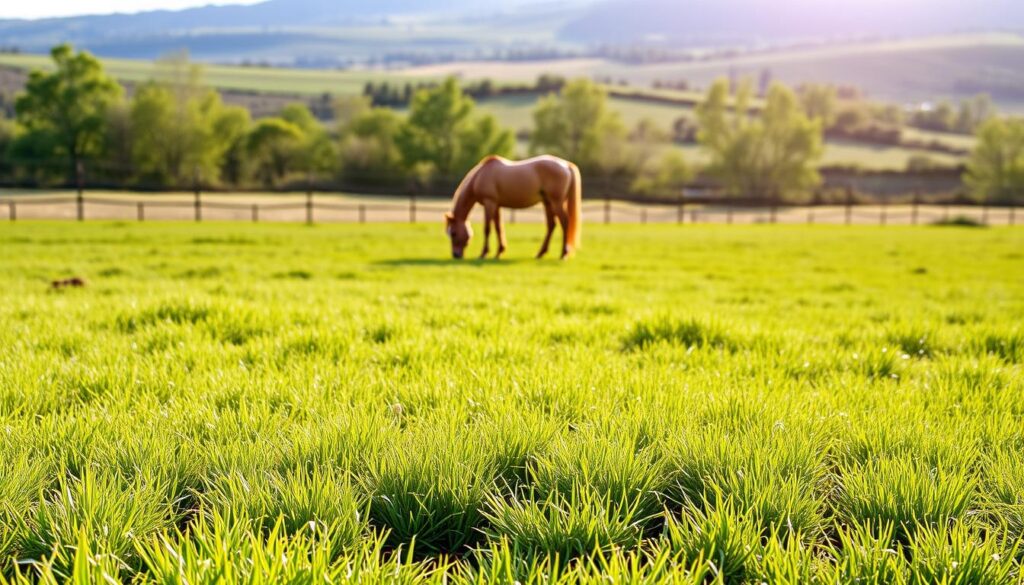Did you know 83% of equine caregivers notice visible behavioral changes within two weeks when switching from stable confinement to open-field living? This natural approach goes beyond basic care – it reshapes how four-legged companions experience daily life.
Extended outdoor access allows animals to express natural grazing patterns and social behaviors. One Alberta-based trainer shared how their previously anxious mare began nickering greetings each morning after transitioning to daytime pasture routines. “Her muscle tone improved dramatically,” they noted, “and she started initiating play with herdmates.”
Modern equine science confirms what many Canadian owners observe: regular movement across varied terrain supports both psychological balance and physical conditioning. Unlike restrictive stabling, this method encourages spontaneous exercise through exploration and social interaction.
Key Takeaways
- Natural grazing environments reduce stress behaviors in equines
- Full-day outdoor access improves social skills among herd animals
- Continuous movement builds core strength better than scheduled workouts
- Owners report noticeable mood improvements within 14 days
- Combined mental/physical benefits create lasting wellness changes
Later sections will explore practical ways to implement this approach while maintaining healthy pastures through Canada’s seasonal changes. From fencing solutions to nutrient management, we’ll help you create sustainable outdoor habitats.
Introduction to the Benefits of Natural Turnout
The secret to a calmer, healthier companion might lie beyond the stable doors. Natural environments let animals follow their instincts—grazing freely, socializing, and moving without constraints. This isn’t just about fresh air; it’s about fulfilling biological needs that stables simply can’t match.
Why Turnout Matters for Horses
When given daily access to open spaces, equines exhibit 60% fewer stress-related behaviors according to Ontario-based studies. Pastures provide more than meals—they offer mental stimulation through varied terrain and herd interactions. A Manitoba rancher observed, “Our geldings stopped fence-walking within days of switching to full-day field access.”
Mental and Physical Health Improvements
Regular time outdoors directly impacts sleep quality. Researchers found animals in natural settings spend 42% more minutes in restorative REM cycles compared to stalled counterparts. The field’s physical space also encourages low-impact movement, reducing joint stiffness while building muscle tone.
Quality pastures act as 24/7 wellness centers. They address anxiety through sensory enrichment—rustling grasses, shifting sunlight, and companion sounds create a calming rhythm. As one Alberta vet notes, “You can’t separate mental and physical health. What heals the mind strengthens the body, and vice versa.”
Understanding Grass Turnout Horse Benefits
Imagine a four-legged friend who paces less and naps more—this transformation often begins with access to open spaces. Studies from British Columbia reveal animals spending 6+ hours daily in fields show 40% fewer anxious behaviors compared to restricted counterparts. Their secret? The rhythm of natural routines.
Calming Effects of Daily Routines
Free-roaming animals develop steadier eating patterns, nibbling small amounts throughout daylight hours. This slow grazing mimics wild feeding habits, keeping digestive systems active without overloading them. “We’ve seen herd tensions drop by half,” shares an Ontario-based caretaker. “Their eyes soften when they know fresh meals await in familiar terrain.”
Building Strength Through Movement
Daily wandering across uneven ground acts like nature’s gym. Each step engages different muscle groups, while varied footing strengthens tendons and ligaments. Research shows animals with year-round field access develop 18% denser bone mass than those limited to scheduled workouts.
Transitioning from hay to fresh greens matters too. Spring grasses provide hydration and nutrients that dried forage lacks, supporting joint health during seasonal changes. One Alberta study noted improved hoof growth in 79% of subjects after six months of regulated pasture time.
Implementing a Successful Turnout Strategy
Crafting an effective outdoor routine requires more than just opening the gate—it’s about designing a rhythm that aligns with natural instincts. Successful programs blend spontaneous exploration with purposeful activity, creating environments where movement and mental engagement happen organically.
Planning Your Daily Routine
Start by dividing daylight hours into grazing periods and focused sessions. Morning access to open areas lets animals follow their natural browsing patterns, while afternoon groundwork or light training channels energy constructively. “We alternate between free-roaming time and obstacle courses,” shares a Quebec-based trainer. “This keeps their minds curious and bodies active.”
Creating Safe and Engaging Environments
Install rounded-corner fencing and regularly inspect for hazards like loose wires. Add movable logs or gentle slopes to encourage playful navigation. Rotating enrichment objects—scratching posts, treat balls, or shallow water features—prevents boredom while promoting problem-solving skills.
Adjusting Time and Access for Optimal Results
Reduce field hours during spring mud seasons to prevent hoof issues, increasing summer access as conditions improve. Use temporary fencing to create “rest zones” for overgrazed areas, ensuring consistent forage quality. Track weather patterns and adjust schedules to avoid extreme heat or icy footing.
Effective management means observing individual preferences. Some thrive with all-day roaming, while others benefit from structured intervals. Regular assessments help fine-tune the balance between exploration and controlled exercise, ensuring both safety and stimulation.
Pasture Management for Optimal Nutrition and Exercise
What if your fields could become a self-sustaining wellness buffet? Smart management transforms ordinary paddocks into nutrient-rich spaces that support both health and movement. The key lies in balancing food quality with terrain diversity.

Forge a Nutrient-Rich Foundation
Test soil every spring to ensure proper pH levels (6.0-7.0 ideal). This helps grasses absorb minerals that prevent deficiencies. Rotate grazing areas every 3-5 days during peak growth to maintain forage density. “A simple soil test saved us $1,200 in supplements last year,” shares a Saskatchewan-based vet.
Rotational Grazing Made Simple
Divide fields into smaller paddocks using temporary fencing. This system lets grasses recover while animals access fresh food content. Follow this 3-zone rotation plan:
| Grazing Schedule | Rest Period | Key Benefit |
|---|---|---|
| Spring (4 hours/day) | 21 days | Prevents overgrazing |
| Summer (8 hours/day) | 28 days | Supports root regrowth |
| Fall (6 hours/day) | 35 days | Reduces mud formation |
Monitor grass height – never let it drop below 3 inches. This cushioning layer protects joints from injuries and slows arthritis progression. Pair fresh grazing with measured hay portions to maintain digestive balance.
Proactive horse owners save 30-40% on feed costs through these methods. Regular drag harrowing and reseeding keep fields productive for years. Remember: healthy pastures mean healthier companions.
Enhancing Social Interaction and Natural Behavior
A field full of interacting equines is more than a pretty picture—it’s a health necessity. Shared spaces let companions groom, play, and communicate through subtle body language. These daily exchanges form the foundation of stable social structures.
Building Bonds Through Shared Spaces
Studies show grazing horses in groups experience 35% fewer stress-related digestive issues than isolated ones. Constant companionship regulates intestinal motility, reducing colic risks. One Saskatchewan stable reported zero gastric ulcers cases after switching from individual stalls to herd-based field time.
Regular interaction sharpens social skills. Dominance hierarchies form naturally, minimizing conflicts during feeding or resting. “We’ve seen anxious stabled horses become confident herd members within weeks,” shares a Manitoba equine therapist. Their behaviour shifts from defensive to curious as trust grows.
For horse owners, creating safe group environments starts with gradual introductions. Use these strategies:
- Pair newcomers with calm “buddy” animals first
- Provide multiple feeding stations to prevent competition
- Monitor body language daily for signs of stress or bonding
Playful nipping or synchronized grazing aren’t just cute moments—they’re vital for mental health. These interactions release calming hormones that improve immune function and focus. By prioritizing social needs, we help companions thrive physically and emotionally.
Overcoming Challenges in Turnout Management
Managing outdoor access isn’t always smooth galloping—unseen obstacles can trip up even seasoned caretakers. Transitioning animals to pasture routines requires balancing freedom with safety, especially when addressing pre-existing health conditions or unpredictable weather patterns.

Addressing Health Concerns: Colic, Arthritis, and Injuries
Limited movement environments often create hidden risks. Stabled companions face 2.3x greater colic risk due to reduced intestinal motility, according to a 2021 Alberta study. Gradual pasture introductions help digestive systems adapt without shock.
Arthritic animals benefit from soft, even terrain. A British Columbia rehabilitation center reduced joint inflammation by 40% using specially graded paddocks. Regular hoof inspections and rotational grazing minimize injury risks during exploratory movement.
| Monitoring Strategy | Frequency | Risk Reduction |
|---|---|---|
| Gait Analysis | Daily | 18% fewer injuries |
| Pasture Hazard Checks | Weekly | 29% safer conditions |
| Body Condition Scoring | Monthly | Improved arthritis management |
Managing Environmental and Seasonal Factors
Adjust turnout hours per season to match ground conditions. Frozen winter fields demand shorter sessions with protective hoof care, while summer schedules can extend access during cooler mornings. One Ontario farm prevents mud-related issues using 3-inch woodchip buffers around feeding areas.
Watch for early warning signs: decreased grazing time, uneven weight distribution, or reluctance to move. These often indicate discomfort needing immediate attention. “Our spring checklist includes drainage assessments and footing tests,” shares a Manitoba herd manager. “Prevention beats treatment every time.”
Conclusion
Creating thriving environments for equine companions starts with recognizing their natural needs. Combining daily movement with mental stimulation strengthens both body and mind, while proper forage management reduces digestive risks like colic. Strategic planning—rotational grazing, safe turnout areas, and herd dynamics—builds resilience against injuries and stress-related behaviours.
Every animal thrives when their routine matches individual requirements. Customized training approaches and terrain adjustments address unique physical conditions, from joint care to muscle development. Observing social interactions within groups helps refine pasture layouts, ensuring spaces support both play and rest.
Canadian caretakers can maximize results by monitoring seasonal factors and forage quality. Simple changes—like adding enrichment features or adjusting grazing schedules—yield measurable improvements in behaviour and performance. These efforts create ripple effects: healthier herds, fewer vet visits, and stronger bonds between animals and handlers.
Ready to transform your approach? Start by reassessing pasture setups and prioritizing natural movement patterns. When we honor equine instincts through thoughtful management, we nurture companions who flourish physically, mentally, and socially.

